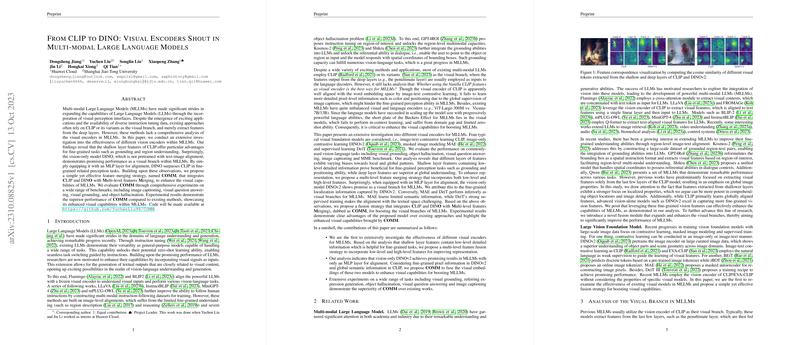An Analysis of "From CLIP to DINO: Visual Encoders Shout in Multi-modal LLMs"
The paper "From CLIP to DINO: Visual Encoders Shout in Multi-modal LLMs" explores the effectiveness of different visual encoders in Multi-modal LLMs (MLLMs). Authored by Dongsheng Jiang et al., this research conducts an in-depth examination of visual encoders such as CLIP and DINO within the context of MLLMs and introduces a novel feature merging strategy, COMM, to enhance the visual perception capabilities of these models.
Key Findings and Contributions
1. Evaluation of Visual Encoders
The paper begins by scrutinizing the most commonly used visual encoders in MLLMs, primarily focusing on CLIP and its deep-layer features. The authors argue that existing methods leveraging only the deep features of CLIP may overlook the granularity captured by shallow layers. Through comprehensive experiments, it is demonstrated that shallow-layer features indeed hold significant advantages for fine-grained perception tasks such as grounding and positioning. Surprisingly, DINO, a vision-only model devoid of text-image alignment pretraining, exhibits promising performance on fine-grained tasks when equipped with a Multi-Layer Perceptron (MLP) layer for feature alignment.
2. Proposed COMM Strategy
Building upon the observations from the visual encoders evaluation, the authors propose a novel feature merging strategy called COMM (Combination of Multi-level features Merging). COMM merges the features of CLIP and DINO, capitalizing on the fine-grained localization information from DINO and the global semantic understanding from CLIP. This strategy is designed to enhance the overall visual capabilities of MLLMs, resulting in noticeable improvements across diverse vision-language benchmarks such as image captioning, visual question answering, visual grounding, and object hallucination.
3. Extensive Experimental Validation
COMM's effectiveness and superiority are validated through rigorous experimental evaluations on various benchmarks:
- Referring Expression Comprehension (REC): COMM achieves significant performance gains, outperforming state-of-the-art generalist VL models and even some specialist models that are fine-tuned for localization tasks.
- Referring Expression Generation (REG): COMM demonstrates enhanced regional understanding, achieving higher CIDEr scores compared to previous methods.
- Object Hallucination Benchmark: The proposed model effectively mitigates the object hallucination problem, showing a higher accuracy compared to other MLLMs.
- Visual Question Answering and Image Captioning: COMM exhibits state-of-the-art performance on VQAv2, OK-VQA, COCO, and Flickr30k benchmarks, underscoring its improved fine-grained visual capabilities.
Theoretical and Practical Implications
The theoretical implications of this research highlight the importance of considering both low-level and high-level features in visual encoders for MLLMs. By demonstrating the effectiveness of DINO's fine-grained features and the merits of multi-level feature merging, the paper provides a fresh perspective on enhancing visual encodings in MLLMs. The insights garnered could lead to the development of more robust and accurate multi-modal models, influencing future research in extending these principles to other visual encoders.
On a practical level, the improved performance of COMM in numerous vision-language tasks hints at potential applications in areas requiring precise visual understanding and interpretation, such as autonomous driving, robotic vision, and advanced human-computer interaction systems.
Future Directions
The research opens several avenues for future exploration. Continuing the investigation into more powerful visual models could unveil additional methods for enhancing the visual branches of MLLMs. Moreover, extending the current evaluation setup to include a broader range of tasks and datasets could provide further insights into the generalizability and robustness of the proposed methods. Future work might also explore optimizing the training processes for even more efficient alignment between visual and linguistic features.
Conclusion
The paper "From CLIP to DINO: Visual Encoders Shout in Multi-modal LLMs" makes significant strides in evaluating and improving the visual branches of MLLMs. The proposal of COMM and its demonstrated effectiveness across multiple benchmarks underscores the potential of integrating diverse visual features for enhanced performance in multi-modal tasks. This work lays the groundwork for more advanced and capable multi-modal models, offering a comprehensive framework for future research and practical implementations in the field.
